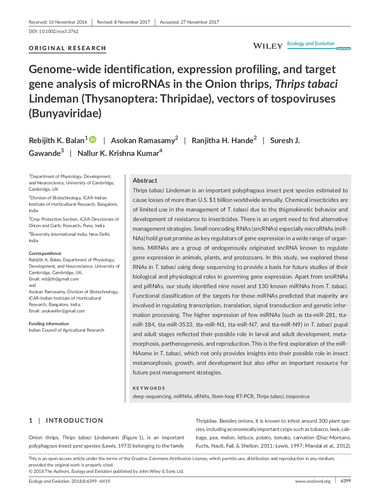Genome-wide identification, expression profiling, and target gene analysis of microRNAs in the Onion thrips, Thrips tabaci Lindeman (Thysanoptera:Thripidae), vectors of tospoviruses (Bunyaviridae)
Thrips tabaci Lindeman is an important polyphagous insect pest species estimated to cause losses of more than U.S. $1 billion worldwide annually. Chemical insecticides are of limited use in the management of T. tabaci due to the thigmokinetic behavior and development of resistance to insecticides. There is an urgent need to find alternative management strategies. Small noncoding RNAs (sncRNAs) especially microRNAs (miRNAs) hold great promise as key regulators of gene expression in a wide range of organisms. MiRNAs are a group of endogenously originated sncRNA known to regulate gene expression in animals, plants, and protozoans. In this study, we explored these RNAs in T. tabaci using deep sequencing to provide a basis for future studies of their biological and physiological roles in governing gene expression. Apart from snoRNAs and piRNAs, our study identified nine novel and 130 known miRNAs from T. tabaci. Functional classification of the targets for these miRNAs predicted that majority are involved in regulating transcription, translation, signal transduction and genetic information processing. The higher expression of few miRNAs (such as tta‐miR‐281, tta‐miR‐184, tta‐miR‐3533, tta‐miR‐N1, tta‐miR‐N7, and tta‐miR‐N9) in T. tabaci pupal and adult stages reflected their possible role in larval and adult development, metamorphosis, parthenogenesis, and reproduction. This is the first exploration of the miRNAome in T. tabaci, which not only provides insights into their possible role in insect metamorphosis, growth, and development but also offer an important resource for future pest management strategies.

